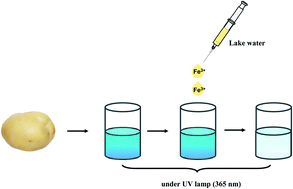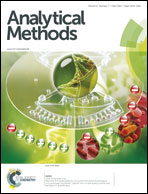Low-cost synthesis of carbon nanodots from natural products used as a fluorescent probe for the detection of ferrum(iii) ions in lake water
Abstract
A simple, low cost, and green method was developed for the synthesis of water-soluble and well-dispersed fluorescent carbon nanodots (CDs) via a one-step hydrothermal treatment of potatoes. The as-prepared CDs exhibit a strong blue fluorescence, with a quantum yield of up to 15%. We further explored the use of these CDs as a novel sensing probe for the label-free, sensitive and selective detection of Fe3+. This is based on strong fluorescence quenching due to the complex formed between the CDs and Fe3+. The detection limit was as low as 0.025 μmol L−1, and different concentrations corresponded to different sensitivities. The linear ranges were 1.0–5.0 μmol L−1 and 5.0–50.0 μmol L−1 at lower and higher concentration ranges respectively, and the recoveries of the spiked water samples were 93.7–101.5%. Therefore, the as-prepared CDs could meet the requirements for the monitoring of Fe3+ in environmental samples.


 Please wait while we load your content...
Please wait while we load your content...